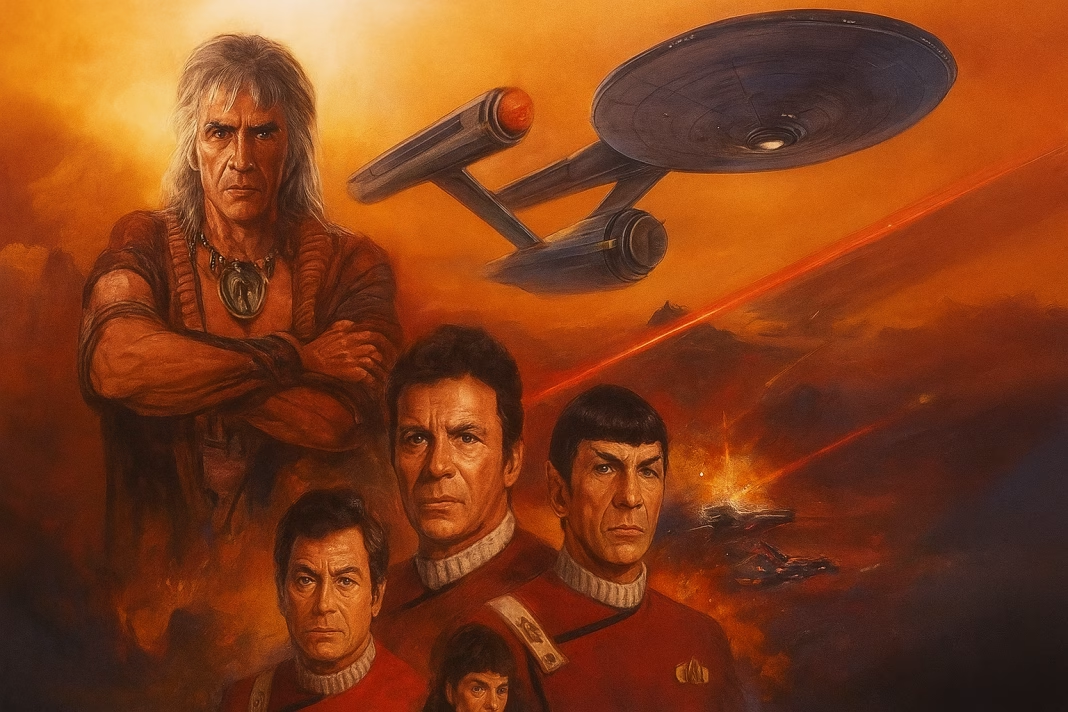1982: The Year Sci-Fi Reached for the Stars
If you were a science fiction fan in 1982, you were living in a golden age. That year gifted audiences with visionary works like Blade Runner, the heartfelt wonder of E.T. the Extra-Terrestrial, and the chilling paranoia of The Thing. Nestled among these cinematic giants was Star Trek II: The Wrath of Khan, a film that not only revitalized a beloved franchise but also proved that intelligent science fiction could thrive in the blockbuster era. Directed by Nicholas Meyer, it stands as a milestone in genre filmmaking — a taut, emotionally charged space opera that blended action, philosophy, and raw human emotion.
A Story of Revenge, Legacy, and Mortality
At its core, The Wrath of Khan is a story about vengeance. The genetically engineered superhuman Khan Noonien Singh, once exiled by Captain James T. Kirk, returns with a burning desire for retribution. He discovers the Genesis Device, a powerful terraforming technology capable of creating or destroying entire worlds. With it, Khan plans to exact his revenge and secure his own twisted vision of triumph.
The plot is deceptively simple. What makes it exceptional is the way Meyer frames it — not as a standard good-versus-evil conflict, but as an operatic clash between two men linked by history, pride, and the slow erosion of time. Kirk is no longer the brash young captain of the original series; he’s now an admiral facing the weight of age and the consequences of past decisions. Khan, portrayed with mesmerizing charisma by Ricardo Montalbán, is more than a villain — he’s a tragic figure consumed by obsession, blinded by his own intelligence and rage.
The Power of the Antagonist
Khan’s presence transforms the film into something far more personal than a typical space adventure. Meyer’s decision to bring back a character from the 1967 episode Space Seed ties the story directly to Star Trek’s television roots, rewarding longtime fans while deepening the narrative. Montalbán’s performance is theatrical yet controlled, radiating both menace and vulnerability. His verbal duels with William Shatner’s Kirk are laced with tension, wit, and an underlying sense that neither man can truly “win” without losing something vital.
Khan is dangerous not because he’s physically stronger or has a superior ship, but because he’s driven by a singular, unrelenting purpose. This obsession gives the film its heartbeat, making every encounter between the Enterprise and Khan’s commandeered starship, the Reliant, feel like an inevitable march toward tragedy.
Precision in Storytelling
Unlike the sprawling, contemplative Star Trek: The Motion Picture (1979), The Wrath of Khan embraces efficiency. With a leaner budget and a brisker pace, Meyer focuses on character arcs and thematic resonance over visual spectacle. The action sequences — especially the cat-and-mouse space battles — are tightly choreographed, drawing inspiration from submarine warfare rather than flashy dogfights.
The climactic battle in the Mutara Nebula is a masterclass in tension. With sensors impaired and visibility reduced, the duel becomes a game of wits, each captain trying to anticipate the other’s moves. It’s a thrilling sequence that underscores the idea that strategy and intellect can be just as cinematic as explosions and special effects.
A World Reimagined
Meyer’s influence extended beyond the script and pacing — he reshaped the look and feel of Star Trek. The redesigned Starfleet uniforms, with their maroon jackets and naval-inspired detailing, grounded the characters in a more tangible reality. This shift away from the sterile, almost clinical design of the first film brought warmth and texture to the universe, making it feel lived-in and functional.
Even the smaller details — the nautical command structure, the aging starships, the lived-in bridge — reinforced the themes of change, mortality, and the passage of time. The Wrath of Khan feels like a story about people in a real organization, not just characters on a soundstage.
The Ensemble Shines
While Kirk and Khan dominate the spotlight, the supporting cast delivers some of their finest work. Leonard Nimoy’s Spock is calm, wise, and quietly humorous, serving as Kirk’s moral compass. DeForest Kelley’s Dr. McCoy injects warmth and humanity, grounding the film’s philosophical musings with plainspoken wisdom. Kirstie Alley makes her debut as Lt. Saavik, a disciplined and by-the-book officer whose interactions with Kirk and Spock add generational contrast.
James Horner’s score, lush and adventurous, elevates the film’s emotional beats and action sequences alike. His music would go on to define Star Trek for years to come, becoming inseparable from the franchise’s cinematic identity.
The Moment That Defined a Generation
For many fans, the emotional centerpiece of The Wrath of Khan is Spock’s sacrifice. Facing the destruction of the Enterprise, Spock enters a radiation-flooded chamber to restore the ship’s warp drive, ensuring the crew’s survival at the cost of his own life.
The scene is not simply tragic — it’s profoundly earned. The quiet dignity of Nimoy’s performance, the raw grief in Shatner’s voice, and the stunned silence of the crew combine to create one of the most memorable moments in science fiction history. It’s a testament to the film’s maturity that it treats death not as a plot twist, but as an inevitable part of life and duty.
Lasting Legacy
Star Trek II: The Wrath of Khan didn’t just rescue the Star Trek film series from stagnation — it redefined what it could be. By grounding its futuristic setting in timeless human themes, it transcended genre boundaries and earned its place alongside the most respected films of the 1980s.
For all the dazzling starship battles and futuristic tech, what stays with viewers are the moments of quiet reflection: Kirk confronting his own mortality, Khan’s final words echoing through the void, and Spock’s farewell through the glass. These are the scenes that linger long after the credits roll.
RATING: ★★★★☆ (9/10) — A triumph of storytelling, character, and heart.
